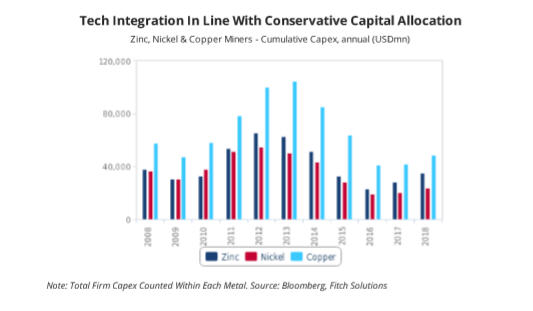Miners are expected to continue using autonomous drone technology as a complement to new IOT solutions to improve mine operation efficiency and worker safety, a new industry trend analysis by Fitch Solutions finds.
Drones with autonomous capabilities and extended flight time will be preferred as both offer further efficiency gains to other available options, while a country’s regulatory environment will be a notable drawback on the pace of autonomous drone advancement and adoption, Fitch forecasts.
The low industrial metal price environment will further incentivise miners to adopt technology enhancements to improve margins, analysts say.
Drones can also capture data and pictures of haul roads and stockpiled ore more frequently, allowing mine operators to assess if current operations are in line with the designed plan and assess if maintenance is needed
Drone technology is a fairly recent addition to mining operations — BHP only began implementing drone technology in 2017 at its coal mines in Queensland and the Olympic Dam mine in South Australia. BHP then announced that overhead surveying usually done by aircraft could now be done by drones, saving the company about $3.4 million a year.
The technology is impactful, as it has the ability to quickly survey various areas of a mining operation, which has led to improved worker safety and productivity gains, the report finds. Drones can more easily inspect and monitor cranes, towers, slopes and blasting areas, reducing worker involvement in more dangerous sites.
Drones can also capture data and pictures of haul roads and stockpiled ore more frequently, allowing mine operators to assess if current operations are in line with the designed plan and assess if maintenance is needed, Fitch reports.

Drones with autonomous capabilities and extended flight time will be preferred as both offer further efficiency gains compared to other available options. Drone technology can currently be used by hiring a third-party drone service, training employees to manually pilot the drones remotely or using autonomous drone options owned by the mine, which can be costly and time consuming. Using a third party could also limit the frequency of drone usage due to the cost of frequently having a third party travel to remote mining operations.
Fitch expects firms will adopt a strategy of ownership of autonomous drones as the technology improves and regulations allow for its use, and expects drones with longer flight time capabilities will be favoured as the drone could theoretically cover a larger area before needing to recharge or replace its battery, saving time.
While Fitch sees increasing adoption rates, analysts maintain that regulation will remain a hurdle in miners’ use of drones in the coming years.
Read the full report here.
